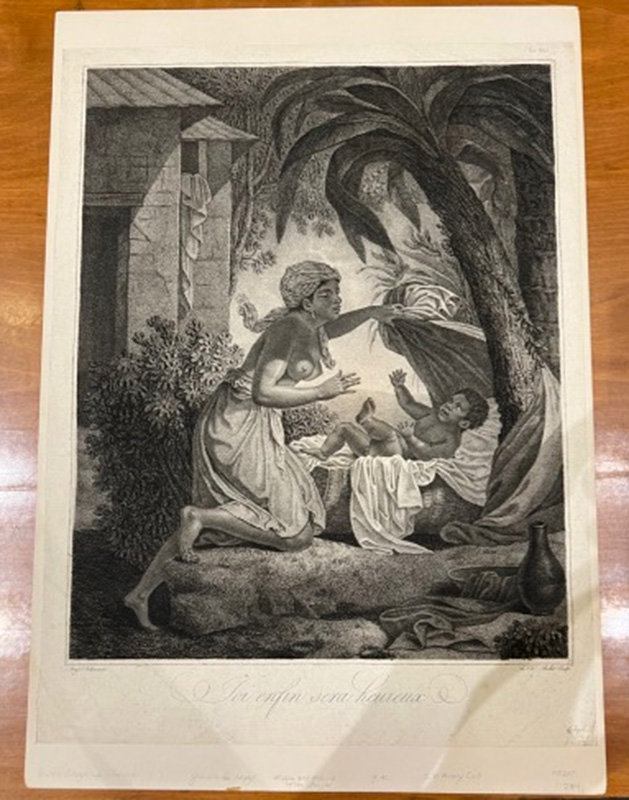Female Printmakers in Revolutionary France
by Sarah Lund
The Decorative Arts Trust Grant contributed greatly to research for my dissertation, “The Matrix of Citizenship: Female Printmakers in Revolutionary France, 1789–1848.” While I spent the academic year in Paris, the grant allowed me to complete extensive research in the United States during the summer. I focused my research at the New York Public Library (NYPL), which contains not only a strong collection of 18th- and 19th-century French prints, but also the only collection dedicated to female printmakers: the Henrietta Louisa Koenen Collection. Following a short-term fellowship at the NYPL, the Decorative Arts Trust Grant allowed me to extend my stay by ten days and complete my research and consultation of well over 200 prints in their collection, including the entirety of the Koenen material.
Highlights of my research span all chapters and periods of my dissertation research. An early find was Citoyenne Rollet’s Toi enfin sera heureux (At last you will be happy) (figure 1), dating to 1794. While I had examined two other prints of a similar theme at the Bibliothèque nationale de France and École des Beaux-Arts in Paris, this work was a new discovery. Rollet’s scene depicts a black mother lifting a blanket to reveal her baby and was likely created to visualize the French Revolution’s abolition of slavery. The print beautifully uses stipple and crayon manner to create deep tonality on its larger scale. Rollet is the only female printmaker I have encountered to explicitly engage with the topic of slavery and the French Revolution. As such, analysis of her work allows me to engage with questions of the intersections of gender and race in revolutionary politics.
Moreover, closer analysis of this work sparked by first-hand consultation uncovered a pendant print held at the Wallace Collection of a black father and his son, which I am planning to consult in a future research trip to London.
Marie Anne Croisier’s La Fécondité (Fecundity) after Rubens and dedicated to the Countess Vergenneau provided another image with which to examine maternity, here from a pre-revolutionary standpoint. Croisier would go on to produce revolutionary ideological images but none that take on maternity or the female body explicitly. This print is helpful not only in setting up her artistic background but also thinking through connections between print and maternity, especially with its dedication to a countess. Similarly, Thérèse Eléonore Lingée’s Le Plaisir des Bonnes Gens (The Pleasure of Good People) dates to shortly before the Revolution but its familial and domestic themes provide an important context. Croisier, Lingée, and Rollet’s prints will all provide key support to my first chapter and its analysis of print and maternity during the 1789 revolution.
Lingée is one of the artists that grounds my second chapter alongside Marie Pauline Soyer. The New York Public Library holds many works by the two female artists and their collaborators, who together engraved numerous prints for large-scale reproductive series, particularly those by Soyer’s father, Charles Landon. This included the Complete Works of Michelangelo, Complete Works of Baccio Bandinelli, Complete Works of Nicolas Poussin, and Annales du Musée (Museum Annales).
My second chapter investigates these female artists’ roles in constructing the art historical canon and its connection to nation building during the Napoleonic Empire. This includes a vast number of Soyer’s prints reproducing the paintings of female artists contemporary to her, for example, her reproduction of Madame Chaudet’s charming depiction of a woman and her dog (figure 2).
This research also led me to unseen work by the most prolific artist central to my dissertation, Joséphine Formentin, including vignettes for sheet music to portraits of political figures. Most importantly, I uncovered additional portraits as part of her early series of revolutionary figures, including a portrait of Charette de la Contrie, a royalist (figure 3). This depiction complicates my interpretation of the portraits, of which I had only encountered pro-revolutionary figures, and proves greatly important for my work on Formentin and her political prints.
Sarah Lund is PhD candidate in the History of Art & Architecture department at Harvard University.
About The Decorative Arts Trust Bulletin
Formerly known as the "blog,” the Bulletin features new research and scholarship, travelogues, book reviews, and museum and gallery exhibitions. The Bulletin complements The Magazine of the Decorative Arts Trust, our biannual members publication.
Click Images to Enlarge
Did you know that clicking on the images in Bulletin posts will allow you to get a closer look? Simply click on an image, and a larger version will open in a pop-up window.










